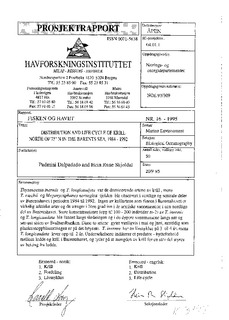| dc.description.abstract | Thysanoessa inermis and T. longicaudata were the dominant krill species whereas
T. raschii and Meganyctiphanes norvegica were seldom observed in the western
and central Barents Sea during 1984 to 1992. None of the krill species found in the
Barents Sea are real Arctic species and penetrate very little into the Arctic water
masses in the northern Barents Sea. . High abundances (up to 100-200 individuals
m-2) of T. inermis and T. longicaudata were found in the slope and adjoining
deep waters south and south east of the Svalbard Bank. Main spawning of
T. inermis and T. longicaudata is in May - June, coinciding with the spring phytoplankton
bloom. T. inermis has a life span of 3 to 4 years while T. longicaudata
can live up to 2 years. Growth took place from late winter to autumn with a
marked negative growth during the late autumn and winter period. The seasonally
oscillating von Bertalanffy growth function gave a reasonably good fit to the growth
curves.
Coinciding with a strong reduction in the older capelin stock from 1984 to 1987,
there was a subsequent increase in the abundance and biomass of T. inermis and T.
longicaudata. A decrease in krill abundance and biomass was observed
corresponding to the rapid recovery and growth of capelin stock up to 1991. This
indicates clear predator-prey interrelationship between planktivorous capelin and
krill in the Barents Sea, and suggests that the krill populations to a large extent are
controlled by predation.
NORSK SAMMENDRAG:
Thysanoessa inermis og T. longicaudata var de dominerende artene av krill , mens
T. raschii og Meganyctiphanes norvegica sjelden ble observert i vestlige og sentrale
deler av Barentshavet i perioden 1984 til 1992. Ingen av krillartene som finnes i
Barentshavet er virkelig arktiske arter og de trenger i liten grad inn i de arktiske
vannmassene i den nordlige del av Barentshavet. Store konsentrasjoner (opp til 100
- 200 individer m-2) av T. inermis og T. longicaudata ble funnet langs skråningen
og i de dypere vannmassene langs sør og sør-øst siden av Svalbardbanken. Disse to
artene gyter valigvis i mai og juni, samtidig som planktonoppblomstringen er på
det høyeste. T. inermis har en livssyklus på 3 til 4 år, mens T. longicaudata lever
opp til 2 år. Krillen vokser fra sen vinter til høst, og har en markert negativ vekst
om høsten og vinteren. Von Bertalanffys vekstkurve med sesongmessige
svingninger viste rimelig god tilpasning til vekstdataene.
Samtidig som bestanden av eldre lodde gikk sterkt tilbake fra 1984 til 1987 var det
en økning i tetthet og biomasse av T. inermis og T. longicaudata. Samtidig med
'den sterke veksten i loddebestanden fram til 1991, ble biomassen av krill lavere
igjen. Dette indikerer et predator - bytteforhold mellom lodde og krill i
Barentshavet, og tyder på at mengden av krill for en stor del styres av beiting fra
lodda. | en |
